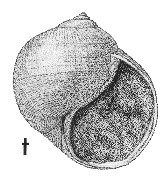
Revised descriptions of New Zealand Cenozoic Mollusca from Beu and Maxwell (1990)

 | Revised descriptions of New Zealand Cenozoic Mollusca from Beu and Maxwell (1990) | 
|
  (Pl. 47t): holotype of Sigaretus drewi Murdoch, Castlecliff, Wanganui, Castlecliffian (TM6794, GNS) |
Beu & Maxwell (1990): Chapter 16; p. 352; pl. 47 t.
Synonymy: Sigaretus undulatus Hutton 1885b, p. 318 (not of Lischke, 1872); Natica (Ampullina) laevis Hutton 1885b, p. 317 (not of Weerth, 1884); Sigaretus drewi Murdoch 1899, p. 320; Euspira venusta Suter 1907b, p. 215; Globisinum wollastoni Finlay 1927b, p. 500 (new name for Sigaretus undulatus Hutton, preoccupied); Globisinum mucronatum Marwick 1928, p. 481; Globisinum flemingi Powell 1931a, p. 98
Type species of Globisinum Marwick, 1924
Classification: Naticidae: Globisininae
Description: Moderately large for family (20-45 mm high), almost spherical, with large aperture, very low spire and very thin, fragile shell. Last whorl very large, enclosing almost all of previously formed shell; anterior evenly rounded, without siphonal canal. Inner lip weakly thickened, regularly curved below parietal area; umbilicus closed or at most a very narrow slit. Sculpture of many regular, exceedingly fine, close spiral threads crossed by weak, irregular growth ridges. Protoconch small, of 2.5 whorls, smooth and polished except for weak spiral cords on last quarter-whorl, sharply marked off from teleoconch.
Comparison: Globisinum drewi is easily recognised by its large size, its almost spherical shape, its very thin, fragile shell lacking the prominently thickened inner lip of other Naticidae, and its very fine, uniform spiral sculpture. The surprisingly many synonyms have been based on minor differences in umbilical diameter and sculptural prominence, but all names refer to a single, moderately variable species.
Distribution: Opoitian-Recent; "Wanganui and Petane" (i.e., Castlecliffian, Wanganui city area, and Nukumaruan, hillside north of Petane Pa, north of Napier, Hawke's Bay, both localities stated for types of both Sigaretus undulatus and Natica laevis) ; "Pliocene, sand and blue clay: Wanganui", i.e., Castlecliff section west of Wanganui (type of Sigaretus drewi); Recent, New Zealand (type of Euspira venusta); Taruwhenua Peninsula, Pitt Island, Chatham Islands, Whenuataru Tuff, Waipipian-Mangapanian (type of Globisinum mucronatum); Waipipi shellbeds, Waverley Beach, west of Wanganui, Waipipian (type of G. flemingi). Globisinum drewi is not uncommon today, dredged in 30 m and more on the mid-outer shelf on soft substrates, and washes ashore rarely along the Paraparaumu-Waikanae coast. It is also moderately common in the Kai-Iwi siltstone beds (Castlecliffian) west of Wanganui, uncommon at some localities in blue-grey siltstone in Hawke's Bay (Nukumaruan), and rare throughout New Zealand in offshore facies of Pliocene age.
Cite this publication as: "A.G. Beu and J.I. Raine (2009). Revised
descriptions of New Zealand Cenozoic Mollusca from Beu and Maxwell (1990). GNS
Science miscellaneous series no. 27."
© GNS Science, 2009
ISBN
978-0-478-19705-1
ISSN 1177-2441
(Included with a PDF facsimile file
copy of New Zealand Geological Survey Paleontological Bulletin 58 in CD version
from: Publications Officer, GNS Science, P.O. Box 30368 Lower Hutt, New
Zealand)